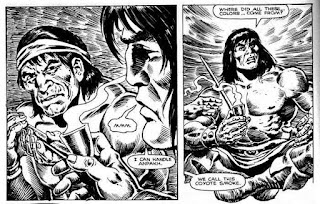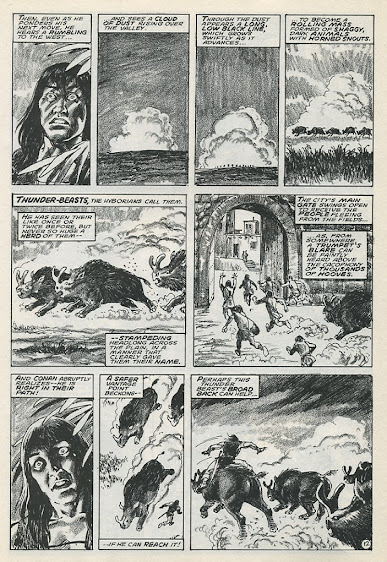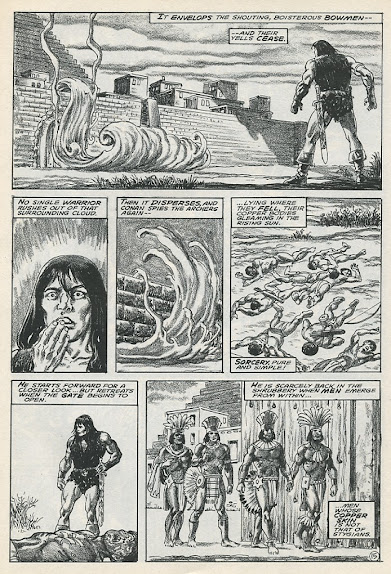Robert E. Howard
Monday, January 8, 2024
Wrarrl the Devourer (with a bit on Imhotep the Ravager)
Thursday, December 28, 2023
Titan's Conan #9
This Roberto del Torre cover for Titan's comics' Conan The Barbarian 9 got my hopes up that they were adapting Howard's "Tower of the Elephant." Del Torre IS returning for this story arc, but so far as I can tell, it's a brand new story. Howard fans will recognize the scene in which Conan confronts the elephant-headed alien, Yag-Kosha, and it is a much better rendering than Cary Nord's for Dark Horse, as accomplished an artist as Nord is. But shouldn't Kosha be green? I suppose it's the lighting. Anyway, it appears they are NOT adapting the story, so no one get their hopes up. Or is it possible that Conan and Yag-Kosha will cross paths again? Doubtful, this DOES appear to be a scene from that story--Kosha is chained to the throne, presumably by the evil sorcerer who has enslaved him.
Chuck Dixon's Siege of the Black Citadel
Friday, December 1, 2023
The Black Stranger, aka The Treasure of Tranicos
"The Black Stranger" is one of the darkest and most disturbing Conan stories Howard wrote. It is nearly novella length. It's mostly about Buccaneers searching for the treasure along a stretch of Pictish Wilderness coast. But at the core of the tale is the story of a corrupt nobleman, Count Valenso, on the run from a mysterious vengeful entity, the "Black Stranger" of the title. Valenso has joined one of two sets of feuding bucaneers, supposedly in hope s of securing Tranicos' treasure himself. But the true reason for his presence among them, which Valenso has kept secret, proves far darker.
The Count is accompanied by his young niece Belasa, and her younger (sister?) Tina, whom he treats with cold indifference. Apparently the two children are orphaned and are forced to live with their callous uncle, and are in among this rough crew of unfeeling adult males because they have no where else to go. Valenso makes it clear later on that he intends to sell both children into slavery or get rid of them. This element of the tale has an almost Dickensian feel to it.
The most disturbing incident in the entire story occur when the Count is discussing with his men how to secure the treasure and survive the Picts, when the young serving girl, Tina, blurts out that she has witnessed a "black man" come ashore in a strange boat limned with blue fire. She was frightened and observed him from behind a ridge of sand. Valenso nearly goes mad, first with horror and astonishment, which then transforms to rage, as whips the poor bewildered child with insane fury, until her back is lacerated and nearly flayed, screaming for her to confess that she is lying. The child screams for mercy and insists she is telling only what she saw. Howard describes the faces of the other men as "uncaring as oxen", the awful scene of child brutality not moving them in the least. Belasa comes to Tina's rescue, as the rage suddenly desert's the uncle, and it is clear to the reader that he is now in state of terrorized despair. There is no question that nothing less than stark terror triggered his brutalization of the child. Needless to say, far from thinking Tina a liar, he believes her every word.
Now when I originally read this, it was a copy of the altered version retitled "The Treasure of Tranicos," and it was co-authored by L. Sprague DeCamp. And something didn't seem right. It is later revealed that the black stranger is none other than Thoth Amon, the Stygian sorcerer, and Conan's old foe. This didn't quite ad up. For one thing, Amon was DeCamp/Carter creation, and had appeared numerous times in the Conan comics. And also the Stygians (proto Egyptians) were dusky skinned, while Tina described the stranger as tall and "black like a Kushite." Knowing how Howard's original Conan stories bordered on belonging to the horror genre, and judging from Valenso's reaction to the news of the stranger's arrival, this being had to something far worse than a human sorcerer, either Stygian nor Kushite.
And thus proved to be the case.
It wasn't until many years later that I finally got hold of the original, unaltered Howard yarn, published along with other similarly dark Howardian yarns in the volume pictured above. When the stanger beats his drum within the woods, a wild storm wrecks Valenso's ship, leaving the men stranded and at the mercy of the indigenous Picts. We learn from Valenso's lips that the stranger is actually a demon cast in a human-like shape, whom he paid a wizard to conjure up to destroy his (Valenso's)enemies, to gain him a position of power. But the corrupt noble tried to cheat the demon, and the dark entity slew the wizard that conjured him, and began pursuing Valenso to the ends of the earth.
Now that's vintage Howard for you!
I won't say more, save---don't read if you don't want to know, slight spoiler---the stranger does get revenge on the count, and has a climactic showdown with Conan. Who unsurprisingly, is the one who recovers the treasure, and uses part of it to make sure the children Belasa and Tina have a secure furtue. One thing Howard makes disturbingly clear in this tale is the utter powerlessness of children, particularly (I imagine) female children among brutal and uncaring adults during the Hyborian age. And that, of course, goes for most of actual recorded history as well.
Bar'aque Sharaq: Michael Fleisher's Deathless Villain
The Bob Larkin painting of Conan facing off with Bor'aque Sharaq. Sharaq was a re-occuring villain during Micheal Fleisher's long run at Savage Sword. He was a Barachan pirate who was captured and tortured by the Argossan navy to find Conan's whereabouts, and they gouged out his left eye in the process. After that, the disfigured corsair became obsessed with killing Conan.
Thursday, July 7, 2022
Conan's Adventures in the Hyborian Americas
In the last post, I explained how in the final current issue of Marvel's King Conan, Conan paddles off into the sunset, at last reaching the verdant coast of an unknown continent. This is either what is now called North or South America, or possibly an island off the coast.
Does this lead directly to L. Spraque L. DeCamp and Lin Carter's Conan of the Isles? Prince Conn is, and always has been a staple of Marvels chronicles of King Conan, is a Lin Carter creation (and has such has long been hated by Conan purists). De Camp intended his and Carter's A Probable Outline of Conan's career to be canonical. This was back during the barbarian boom of the sixties and seventies, Conan was going great guns at Marvel. The purist, with reason, vehemently disagreed, and now only the original Conan tales by Howard are considered canon, while the rest are basically pastiches. Therefor, all you can do is speculate.
Conan of the Isles has the sixty some year old monarch, bored of tedious court life, venturing across the Western Sea, to battle a conclave of wizard who survived the sinking of Atlantis. Most of the action takes place on Antilan islands off the coast of the Central American mainland, in the city of Patchuan ruled by the demon god Xotli. I remember from the book and comics adaptation the giant dragon-lizards in the pit beneath the city, that are dispose of the corpses of those sacrificed to the demon-god, and how Conan sets the dragons loose to terrorize the city. After defeating the priests and their evil god, Conan ventures further west, knowing there lies the even greater kingdom of Mayopan (undoubtedly proto-Mayans), "tiger-like cats" (jaguars), and another apparent demon god the Quetzalcoatyl (an Aztec deity; the Mayan name for essentially the same god is Kukulcan). It is easy to see the ancient meso-American culture in the place and character names, as well as a connection of Atlantis with those cultures.
None of this violates canon, as the tales of Conan as king by DeCamp and Carter, and the subsequent ones by Marvel, mostly by Roy Thomas, are based on a passage by Howard himself, that he journeyed to Khitai and other lands, including the two great continents across the Western ocean.
But's there's no mention of Patchuan or Xotli here. What the authors seem to have done is return to the source material, ignored the events of Conan of the Isles, and written their own version of what Conan might have encountered west of the Hyborian continent.
The fly in the ointment here is Prince Conn. As with Conan of the Isles, the prince assumes the throne after his father's abdication, but little else remains the same. Conn is already a part of Marvel's continuum, and was invented by DeCamp and Carter. Plus he's already a part of Marvel's expanded universe.
As is, of course. Conan of the Isles itself, which was adapted by Marvel in one issue of the annual "Red Shadows, Black Kraken", scrapped the next year in favor of a Jim Owsley story of two blonde twins with powers, one good the other evil, born during the era of King Kull--but that's another story. The entire adaptation of Carter's and DeCamp's pastiche was published in a graphic novel.
So what gives here?
Of course, Marvel hasn't always been consistent with it's use of Conan anyway. One thing I've always been confused by is whether of not the Marvel incorporated Howardian continuity into their own "universe." This was debated back and forth in the letters column back in the day. It seemed settle when one writer opined that Howard's Conan tales take place in a world that "will eventually become our world today, not the Marvel super heroes' world". The editors seemed to agree and that was that. Only there was a (very good) issue of What If, drawn by Ernie Chan that had Conan drawn into the modern world through the well of the sorcerer Shamash Shum Ukin, a villain from an early issue of Savage Sword. During his stay, there is a very brief cameo by Peter Parker and Mary Jane, proving that it's the Marvel super heroes' world after all! Another What If had Wolverine travel back to the Hyborian Age to team with Conan. There was at least one other What If that had Conan in the modern world, but I know next to nothing about it, other than it was still the same universe as Marvel. These instances were often dismissed for the fact that they were "what ifs" only, and never canonically occurred. But the Official Handbook of the Marvel Universe published around that time, made repeated references to the Hyborian Age, even including an entry on the Stygian god Set. The inclusion of Howard's hero in the now current Savage Avengers proves that Conan is, nowadays at least, a mainstay in the Marvel universe, as these stories are no "what ifs", but I have little idea of what goes on at Marvel these days. Only that having Conan adventure in modern Las Vegas (Zamora was the Hyborian Age's own "City of Sin"), is a far cry from the Howardian continuum, or even DeCamp's, Carter's, and Roy Thomas's subsequent embellishments.
But I've let myself get sidetracked again.
Conan of the Isles wasn't Conan's only venture to the Americas during Marvel's run, either. Sometime during the 90s Savage Sword run, Conan, while king of Aquilonia, traveled up the coast of South and North America, encountering a civilization that was either pro-Inca or Aztecs (probably Incan, as the name of capital Kuzco, suggests), the American Indians, and finally the Inuit where he slays a huge white whale feared by the natives as a god. On the page that featured a map of Western Hyborian age world-continent, they presented a map of the American continents as they existed during that time. As Africa and Eurasia were merged into one super landmass, so were the Americas, the Central American landmass being much wider and vaster.



King Conan (the Comic) is Dead
Marvel's current run on Conan has finally breathed its last. There's been a lot of excuses for the recent sparseness of Conan comics, from Covid-19 to a lack of paper, but what I've always suspects to be the root cause is plain old flagging sales. Marvel's newest King Conan was always intended to be a mini-series, and even that has come to an end, and that's pretty much it for Marvel's Conan (for now, at least), unless you count Conan's regular appearance in Savage Avengers, and I don't count that.
Marvel attempts to wrap up the entire Conan story with this tale, while still leaving the door open for possible future adventures, and they do a decent enough job. While exploring the Western Ocean, Conan is ship-wrecked on a cursed island far out at sea, inhabited by the zombies of previous shipwrecked adveenturers. Marooned with him is Conan's reccuring foe and mortal adversary, the Stygian wizard Thoth-Amon, and there ensues a dramatic show-down. The mistress of the island is a displaced Meso-American Princess, who was once fell in love with an Aquilonian adventurer, who betrayed her and sacked her city, and now thirsts for revenge against all Easterners. She is bound by the curse to the island, until another unfortunate takes her place. She also commands great red apes and snow-tigers, both Hyperborian natives who she uses to attack Conan, and then tries to use Toth-Amon to blackmail him, until she learns the two are foes. While all this ensues, we're treated to flash backs in Aquilonia, of King Conan trying to get his son Prince Conn to go off adventuring on his own, like he did as a youth. There ensues a non-lethal sword battle between father and son, and at last Conan relents, and decides that he is the one who needs to go on adventuring again. Conn assumes the Aquilonian throne. Toth-Amon driven by his own lust for power, takes the Princess's place, setting her spirit free, and Conan paddles out further west, in the final panel reaching the coast of what is now South or North America.
And that's where the story leaves us. What will happen next? Conan never truly dies, because he's always revived every few years. That he only persists in Savage Avengers though, speaks volumes of how currently the trend favors super-heroes. it's a wonder Conan was brought back at this time at all.
And I think I've split this post, because it will take too long to explore Conan's adventures in the Americas.
























